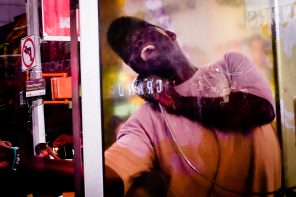The afterlife of Masahisa Fukase continues apace. In the last year I’ve picked up Slaughter (staged shots of his first wife, Yoko, posing in a slaughterhouse in 1962) and Wonderful Days (cat photos), and now from Mack comes a new book, Hibi.
Fukase died in 2012, but twenty years earlier, after tumbling down steps at his favorite Shinjuku bar, he suffered a brain injury that left him in a coma. Any works we see now are from before 1992.
It was that year that Fukase finished work on what Mack delightedly calls “literal” street photography—shots of actual roads, with a particular fascination with dark fissures cracking along the concrete or asphalt, and forming not wholly uninteresting abstract patterns. Sometimes we get a passerby, a child’s chalk scrawl, and so memorably that the shot is on the book’s cover, what’s presumably the photographer’s shoe. So much for a major plot turn.
Perhaps knowing that nothing but shots in which you point your camera at the street wasn’t quite enough, Fukase went on, as the publisher puts it, to overlay “a set of bromide prints with fluid drawings in brightly colored inks, and on every image the physical presence of the artist is traced, a shadow-presence which seems to offer a reading, an interpretation but one that can never be fully resolved.” Well, perhaps, though without the lines, dabs, smears, and washes of color, the run of black-and-white shots of cracking street surfaces (there are 111 in the book) would in essence demonstrate not much more than a truly gifted artist obsessively following an idea much further than it should go.
Of course, the reason Hibi is of great interest is because it is the work of an artist who obsessively followed an idea, a brilliant one, much further than it ever should have gone.
I’m talking of Ravens, Fukase’s masterpiece from 1986.
Ravens, that most haunting and literary of photobooks, was deemed in 2010 by The Guardian to be the best photobook of the last 20 years. No argument here. If a primary job of a great book is to take you far into another world, and along with that the author’s deepest consciousness, then Ravens does just that.
Curiously enough, there are two English phrases specific to a flock of ravens: storytelling and unkindness. Consider that. What words could better encapsulate Fukase’s book, for in Ravens there are, well, lots of unkind ravens—storytellings of them, perched on stark, bare trees or darkening the daylight sky—in the majority of shots. In Japan, I’m told, ravens are symbols of menace, of somber failure, and they sure connote that here. Most of the photos were taken just after Yoko, his first wife so memorably portrayed in Slaughter, had left him; and many were shot during train trips home. Powerful, compulsive thoughts made manifest on film—can photography do anything more? Even the pictures without a raven in them seem possessed by the birds’ dark spirits. In one a woman’s hair is flying out wildly on a boat trip like a wild bird gone berserk. The famous cat shot in the book shows an animal just as feral and nightmarish as any shadowy, preying raven perched on a power line.
What makes Ravens so stunning? Certainly, the black-and-white, post-Provoke-style shots, blurry, like shadows of dreams. Then there’s the wealth of composition, no picture even close to conventional. But perhaps Ravens’ greatest power comes from Fukase’s obsessive chasing of these dark, hovering presences.
Ponder this:
“Aside from those more obvious considerations touching Moby Dick, which could not but occasionally awaken in any man’s soul some alarm, there was another thought, or rather vague, nameless horror concerning him, which at times by its intensity completely overpowered all the rest; and yet so mystical and well nigh ineffable was it, that I almost despair of putting it in a comprehensible form. It was the whiteness of the whale that above all things appalled me.”
That’s Herman Melville in that greatest of all turn-a-creature-into-a-symbol books, Moby Dick. Fukase’s Ravens has a similar resonance: his birds “so mystical and well-nigh ineffable” that they can mean anything and everything to us. The numerous photos with smudges of bird shapes, what are they but the flitting, wingy shadow play of nightmare. The murky gray sky studded with a boundless flock—a darkness that will never end. One winged shape against a long smear of smokestack smoke—evil in its proper element. That feral cat—perhaps it’s hunting its own dream of a raven, to who knows what kind of success. The naked corpulent woman in bed like an inscrutable Buddha … I won’t even hazard a guess as to what she means.
But I can’t turn away.
The above are just photos I flipped to randomly. There’s not a shot in Ravens that isn’t enigmatic, compelling, the very trigger of our deepest, most haunted intuitions and visions.
Hibi is with us now because Fukase, our photographic Ahab, is an artist of singular value, and Mack should be commended for bringing any work of his to us. Still, the book that should be coming out again is Ravens. Copies on the open market run from $400 to $2,000, and those are just for reprints. If you want to meet Melville’s white whale, you can download Moby Dick for free from the Gutenberg project. It’s time for a high-quality, celebratory reprinting of “the best photobook of the last 20 years,” Masahisa Fukase’s work of stunning, inscrutable genius, Ravens.
Robert Dunn is a writer, photographer, and teacher. His novels include Meet the Annas and Stations of the Cross. His photobooks OWS, Angel Parade, and Meeting Robert Frank are in the permanent collection of the International Center of Photography (more info here). In Spring 2017, Dunn will teach a course called “Writing the Photobook” at New School University in New York City.







1 Comment